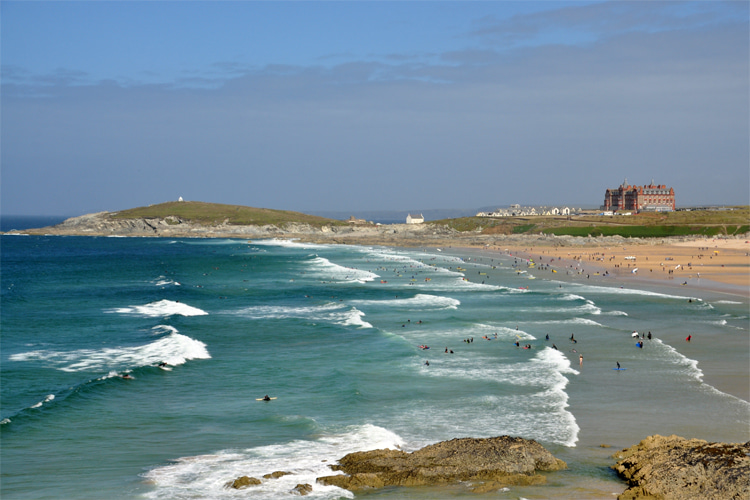Fistral Beach is the most popular surfing destination in the United Kingdom. It is located in Newquay, Cornwall, England, and is often named the capital of British surfing.
Fistral Beach is renowned for its consistent surf conditions and is considered to be one of the best surf spots in Europe, attracting hundreds of thousands of surfers every year.
The 600-meter-long beach break is surrounded by a spectacular dune system and golf course and sheltered by two magnificent headlands.
Newquay is also home to the Boardmasters Festival, a week-long surf and music event that has been running since 1981.
The history of surfing in Fistral Beach is deeply rooted in the growth of Cornwall country as a tourist destination.
Anchored in the fishing and tin mining industry for centuries, the southwesternmost point in England gradually established itself as many Londoners' go-to summer holiday seaside resort.
Both the south and west coasts of Cornwall provide plenty of laid-back towns and pristine sand strips capable of draining the stressful vibes of the English capital.
Moreover, Cornwall is a swell magnet fully exposed to the swinging temperament of the Atlantic Ocean.
That said, British surfing's ground zero is the ultimate playground for all types of wave riding disciplines in the westernmost area of England's South West Peninsula.
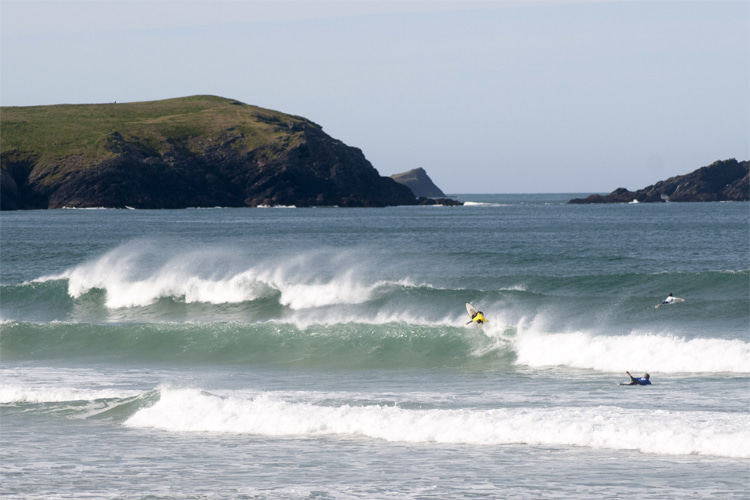
Making Waves Since 1929
Lewis Rosenberg is the pioneer of surfing in the United Kingdom.
He rode the first British waves in 1929 at Holywell Bay, just three miles west-southwest of Newquay's Fistral Beach.
Rosenberg was accompanied by three friends - brothers Fred and Ben Elvey and Harry Rochlen - and stood up on an 8' balsa wood board he carved himself.
Interestingly, Rosenberg's adventures in the Cornish surf were documented for eternity in a 9.5 mm film now available in the Museum of British Surfing.
In 1935, a dentist named Jimmy Dix showed up one summer day with a 14-foot surfboard - shaped by the legendary Tom Blake - strapped to his car.
"Dix's efforts were less than successful, but they inspired a local named Pip Staffieri [pictured below], who set out to build a copy of Dix's board," notes Chris Santella in "Fifty Places to Surf Before You Die."
"He succeeded both in his woodworking and in riding the board, much to the amusement of his fellow citizens."
World War II meant surfing in England was pretty much frozen for much of the 1930s and 1940s.
However, the 1960s surf boom re-ignited the British interest in wave riding, mainly thanks to a group of American and Australian surf explorers arriving in Newquay in search of summer lifeguard jobs.
Bob Head, Ian Tiley, John Campbell, and Warren Mitchell brought their fiberglass boards, caught the attention of the town's youth, and sparked a new fire in town.
Soon, locals Bill Bailey and Doug Wilson founded the European Surfboard Company, and Newquay quickly became Great Britain's epicenter of surfing.
And so, inspired by The Beach Boys' surf music, the British discovered their love of surfing.
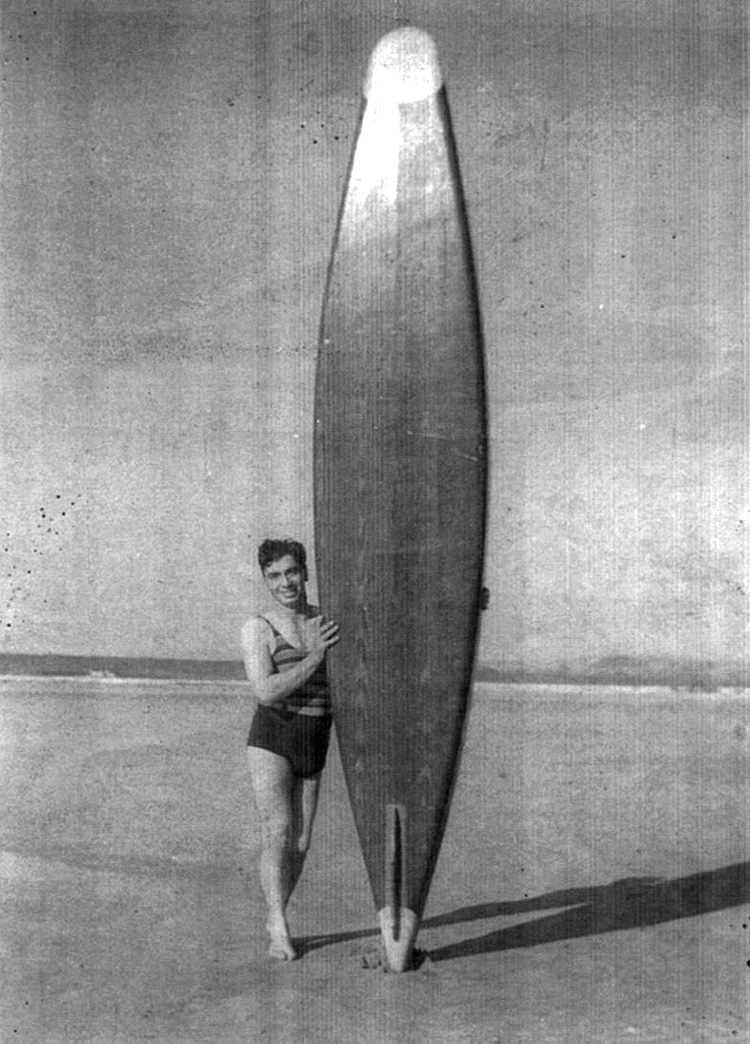
The Mechanics of Fistral Beach
The beach is facing the Celtic Sea - WNW - and is exposed to the full force of the Atlantic Ocean's currents and SW/WNW ground swells.
NW groundswells are blocked out by Ireland, producing the classic summer flat spells.
The presence of a nearby natural reef - The Cribbar - and the funnel effect created by the northern (Towan Headland) and southern (Pentire Headland) promontories transform Fistral Beach into a highly consistent, all-around surf spot.
And with southeast winds, Newquay's premier surf break becomes a surfer's paradise - usually crowded but certainly manageable.
"At South Fistral, there's a left-hand wedging wave," explains Rob Barber, a veteran Cornish bodyboarder, author, and founder of the Newquay Activity Centre.
"On big days, you can walk out on a breakwater and drop in behind the waves, which is a time-and-energy-saver."
"Middle Fistral has a lovely peaky wave that's great fun to ride."
"North Fistral is the main attraction. It's where any visiting surfer worth his salt goes to prove his mettle."
"When the tide is low, it's barrely; when it's shore-breaky, it's good for high-performance maneuvers. This is where the main Newquay competitions are held."
"Beyond North, there is also Little Fistral [beneath the iconic The Headland Hotel and Spa]. A facet that makes Fistral special is that it has waves for surfers of all abilities."
The tidal range in Fistral Beach can be huge.
The difference in height between the high tide and the low tide reaches 7.8 meters.
As a result, the time when a certain break is working can be short, meaning that a previous analysis of the conditions is always a wise move.
"You might have a sandbank that's breaking well for 30 or 40 minutes, but then it's gone. Locals take an almost military approach to assaulting the waves," concludes Barber.
The best time to surf in Fistral Beach is from autumn to spring when the North Atlantic is active and sends powerful swells toward the European shorelines.
During the summer months, the beach can get crowded with tourists, making it difficult to find a good surf spot north or south of Newquay.
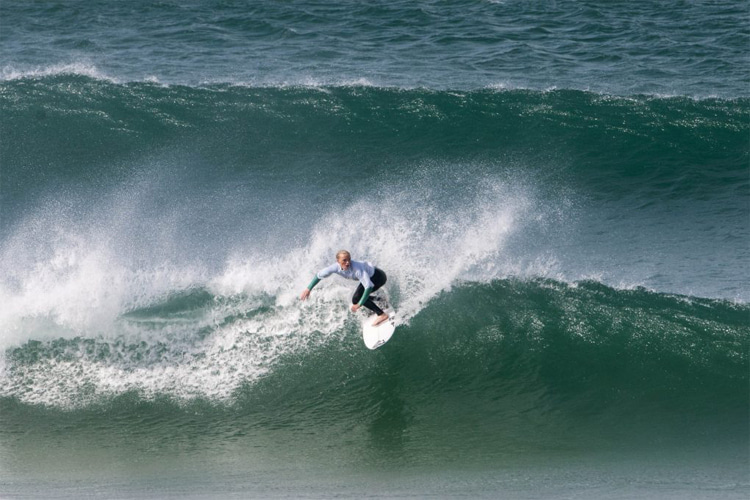
Newquay: A Lively Surf Town
Fistral Bay is a five-minute walk from the town center, but it has good facilities, including showers, shops, restaurants, pubs, discos, and fancy cafés.
It is easily accessible by car or public transport, with several unbelievably expensive car parks located near the beach.
There are also several bus routes that stop near the sand strip, making it easy to reach other parts of Cornwall.
The premier UK surf destination caters to surfers of all levels, from beginners to experts, with its two-to-12-foot (0.6-3.6 meters) waves.
There are several surf schools and shops located on the beach, offering surfing lessons and equipment rentals.
England's ultimate surf city is also the center of the sport's industry in the United Kingdom, with a series of local surfboard shapers and brands, national and international surf contests, surf-at-night events, music festivals, and other cultural gatherings.
If you're visiting England and dream of scoring a surf session in the kingdom, Fistral Beach will surely provide you with the goods.
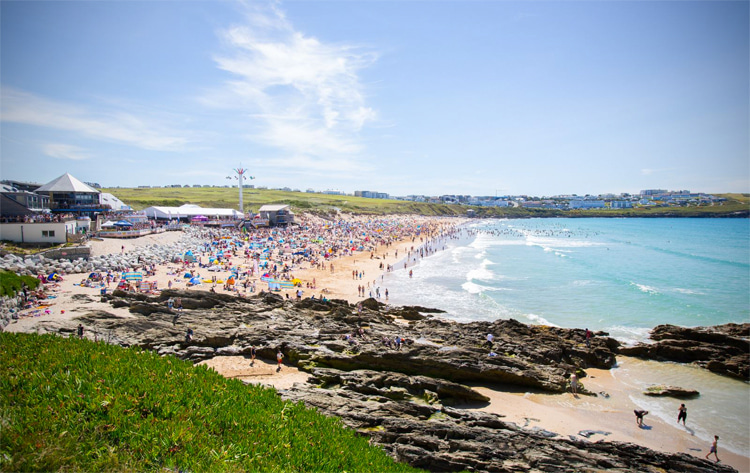
Fistral Beach, Newquay, England | ID and X-Ray
Location: Fistral Beach, Newquay, Cornwall
Type of Wave: Beach Break
Length: Up to 100 yards (100 meters)
Best Swell Direction: SW/WNW
Best Wave Size: 2-12 Feet
Best Wind Direction: SE
Best Tide: All Tides
Best Time to Surf: Fall (September-December)
Skill Level: Beginner to Professional
Best Board: Shortboard, Longboard, and Bodyboard
Crowd: Mostly Crowded
Water Quality: Fair/Good
Hazards: Localism, Pitching Take-Off, Close-Outs, and Compacted Sandbank
Bottom: Sand
Water Temperature: 48-62 °F (9-17 °C)
Getting There: Car, Bus, Bike, Walk
